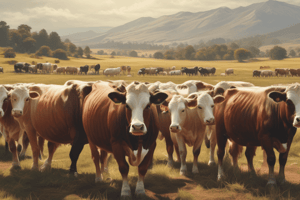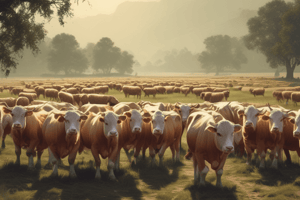Podcast
Questions and Answers
What is the duration of gestation in cattle?
What is the duration of gestation in cattle?
- 10 months (correct)
- 12 months
- 14 months
- 7 months
Which of the following is a sign of a sick calf?
Which of the following is a sign of a sick calf?
- Rapid, noisy breathing (correct)
- Alert and active
- Good appetite
- Shiny, healthy coat
When should heifers be bred for spring calving?
When should heifers be bred for spring calving?
- 60 days after the older cows
- At the same time as the older cows
- 30 days before the older cows (correct)
- Not bred at all
What is the purpose of isolating new animals before introducing them to the herd?
What is the purpose of isolating new animals before introducing them to the herd?
How long does it take from conception to plate in cattle production?
How long does it take from conception to plate in cattle production?
What is the main characteristic of micro minerals?
What is the main characteristic of micro minerals?
What is the primary function of vitamins in the body?
What is the primary function of vitamins in the body?
What is the primary function of water in the body?
What is the primary function of water in the body?
What is the key difference between ruminant and non-ruminant digestive systems?
What is the key difference between ruminant and non-ruminant digestive systems?
What is the primary consideration for quality grading of swine carcasses?
What is the primary consideration for quality grading of swine carcasses?
What is the main characteristic of PSE pork?
What is the main characteristic of PSE pork?
What is the role of the cecum in non-ruminant digestive systems?
What is the role of the cecum in non-ruminant digestive systems?
What is the grading category for carcasses with unacceptable lean or bellies that are too thin?
What is the grading category for carcasses with unacceptable lean or bellies that are too thin?
Why do carcasses with higher back fat thickness have higher yield grades?
Why do carcasses with higher back fat thickness have higher yield grades?
What is the difference in dressing percentage between Packer style and Shipper style dressed hogs?
What is the difference in dressing percentage between Packer style and Shipper style dressed hogs?
What is the primary function of minerals in the body?
What is the primary function of minerals in the body?
What is a characteristic of proteins?
What is a characteristic of proteins?
What is the main difference between the composition of carbohydrates and fats?
What is the main difference between the composition of carbohydrates and fats?
What is the role of vitamins in animal nutrition?
What is the role of vitamins in animal nutrition?
How are minerals classified in terms of the amounts needed by the body?
How are minerals classified in terms of the amounts needed by the body?
What is the primary consideration for quality grading of swine carcasses?
What is the primary consideration for quality grading of swine carcasses?
What is the characteristic of PSE pork?
What is the characteristic of PSE pork?
Why do carcasses with higher back fat thickness have higher yield grades?
Why do carcasses with higher back fat thickness have higher yield grades?
What is the grading category for carcasses with unacceptable lean or bellies that are too thin?
What is the grading category for carcasses with unacceptable lean or bellies that are too thin?
What is a sign of a sick pig?
What is a sign of a sick pig?
How do Shipper style dressed hogs differ from Packer style dressed hogs?
How do Shipper style dressed hogs differ from Packer style dressed hogs?
Which of the following is a biosecurity measure to prevent disease introduction?
Which of the following is a biosecurity measure to prevent disease introduction?
What is a key aspect of good management for disease prevention?
What is a key aspect of good management for disease prevention?
Why is it important to isolate new animals before introducing them to the herd?
Why is it important to isolate new animals before introducing them to the herd?
What is a goal of providing good management practices for disease prevention?
What is a goal of providing good management practices for disease prevention?
What is the normal heart rate of a healthy animal?
What is the normal heart rate of a healthy animal?
What is the primary function of carbohydrates in animal nutrition?
What is the primary function of carbohydrates in animal nutrition?
What is the normal temperature range for a healthy animal?
What is the normal temperature range for a healthy animal?
What is the primary function of lipids in animal nutrition?
What is the primary function of lipids in animal nutrition?
What is the normal respiratory rate for a healthy animal?
What is the normal respiratory rate for a healthy animal?
Flashcards are hidden until you start studying
Study Notes
<|start_header_id|>assistant
Vitamins and Minerals
- Vitamins are required for health, development, and metabolic reactions, and are needed in small amounts.
- There are two groups of vitamins: fat-soluble and water-soluble.
- Micro minerals, or trace minerals, are also essential for life and health.
Water
- Water is the most important nutrient, making up 70% or more of plants and animals.
- Functions of water in the body include:
- Controlling body temperature
- Enabling living organisms to hold their shape
- Transporting nutrients and waste
- Aiding in digestion
- Making up body fluids
Digestive System
- The digestive system is a tube extending from the mouth to the anus, with associated organs like the liver, teeth, and pancreas.
- Digestive systems vary depending on whether the animal is a herbivore, carnivore, or omnivore.
Non-Ruminant (Monogastric) Animals
- Non-ruminant animals have a single compartment in their stomach, swallow their food after chewing, and do not regurgitate.
- Examples of non-ruminant animals include pigs, humans, bears, and dogs.
- Food is mixed with digestive juices in the single compartment stomach, with little bacterial action.
Health
- Normal body temperature: 101-104 degrees Fahrenheit
- Normal respiratory rate: 15-30 breaths per minute
- Normal heart rate: 59-86 beats per minute
Nutrition
- All feeds include six basic nutrients: protein, carbohydrates, lipids, minerals, vitamins, and water.
- Protein provides essential amino acids, is essential for growth and repair, and contains carbon, hydrogen, oxygen, and nitrogen.
Carbohydrates
- Carbohydrates are used for energy, growth, and reproduction, and represent the largest part of an animal's feed supply.
- They are composed of carbon, oxygen, and hydrogen, and include sugars, starch, and cellulose.
Fats
- Fats are a concentrated source of energy, providing up to 2.25 times as much energy as carbohydrates.
- They are composed of carbon, oxygen, and hydrogen, and are found in every cell in the body.
- Functions of fats include:
- Energy reserves
- Protection for vital organs
- Insulation of the body
Minerals
- Minerals are needed in nearly all parts of the body, but are found primarily in bones and teeth.
- They are divided into two groups: macro minerals and micro minerals.
- Minerals are involved in heartbeat, nerve transmission, and make up important parts of many organic materials, including blood.
Meat
- Quality grades of swine carcasses are determined by:
- Quality of lean meat
- Belly thickness
- Grades for carcasses with acceptable lean quality are:
- U.S. No. 1
- U.S. No. 2
- U.S. No. 3
- U.S. No. 4
- Utility
- Carcasses with unacceptable lean or bellies that are too thin are graded U.S. Utility.
- Dressing percentage is the percentage yield of chilled carcass in relation to the weight of the live animal.
- Hogs may be dressed in two ways: packer style and shipper style.
Signs of a Sick Pig
- Poor appetite, weakness, and lethargy are signs of a sick pig
- Rapid, noisy breathing, dry, crusty, or runny nose, limping, and changes in skin or developed abscesses are also signs
- Diarrhea is another indicator of illness
Biosecurity
- Herd additions, isolation of new animals, people movement, pig movement, and disease transmission on-farm are biosecurity concerns
- Vermin control, vehicles, water, and feed can also introduce diseases
Good Management for Disease Prevention
- Be alert for signs of disease and stress-causing conditions
- Provide clean, disinfected quarters with adequate ventilation and sunlight
- Ensure proper drainage and protect pigs from environmental stressors
- Practice rigid sanitation and manure removal, and provide a well-balanced diet
- Get accurate diagnosis of health problems immediately and avoid unnecessary stress
- Buy disease-free stock, isolate new animals, and follow a set vaccination program
- Be cautious of visitors and dispose of dead animals immediately
Reproduction
- Estrous cycle lasts 21 days
- Gestation period is 114 days
- Nursing lasts 3 weeks, growing 9 weeks, and finishing 9 weeks
- Processing takes 1 month, and conception to plate takes about 10.5 months
Litter Management
- Maintain body temperature and protect from injury
Health
- Normal temperature: 101-104°F
- Normal respiratory rate: 15-30 breaths per minute
- Normal heart rate: 59-86 beats per minute
Nutrition
- Six basic nutrients: protein, carbohydrates, lipids, minerals, vitamins, and water
Protein
- Provides essential amino acids
- Needed for growth and repair
- Forms muscles, internal organs, skin, hair, wool, feathers, hoofs, and horns
- Contains carbon, hydrogen, oxygen, and nitrogen (16%)
Carbohydrates
- Used as energy for body functions
- Largest part of an animal's feed supply
- Include sugars, starch, and cellulose
- Composed of carbon, oxygen, and hydrogen
Fats
- Concentrated source of energy (2.25 times carbohydrates)
- Form cholesterol, steroids, and other body compounds
- Found in every cell, affects skin and hair condition when absent
- Composed of carbon, oxygen, and hydrogen
Minerals
- Needed in nearly all body parts, primarily in bones and teeth
- Affect heartbeat and nerve transmission
- Divided into two groups: macro and micro minerals
Meat
- Quality grades consider lean meat quality and belly thickness
- Carcasses with unacceptable lean or bellies that are too thin are graded U.S. Utility
- Dressing percentage is the percentage yield of chilled carcass to live animal weight
- U.S. No. 1-4 grades have specific dressing percentages
Grading Exceptions
- Carcasses with thin muscling cannot grade US 1
- Carcasses with last rib back fat > 1.75 inch must grade US 4
- Carcasses with unacceptable quality must grade US Utility
PSE: Pale Soft Exudative Pork
- Causes meat to be very light gray in color
- Muscle is soft in texture, lacks ability to hold water, and exhibits separation between muscles
- Although PSE pork has acceptable nutritive value and taste, some protein and vitamin loss occurs
Studying That Suits You
Use AI to generate personalized quizzes and flashcards to suit your learning preferences.



